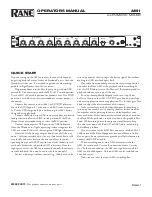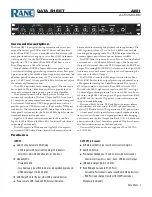
44
Note:
Heat Index is equal to the air temperature at or below 0° F (-18° C).
Temperature/Humidity/Sun/Wind (THSW) Index
The THSW Index uses humidity and temperature like for the Heat Index, but also
includes the heating effects of sunshine and the cooling effects of wind (like wind
chill) to calculate an apparent temperature of what it “feels” like out in the sun.
The THSW Index requires a solar radiation sensor.
Humidity
Humidity itself simply refers to the amount of water vapor in the air. However, the
total amount of water vapor that the air can contain varies with air temperature and
pressure. Relative humidity takes into account these factors and offers a humidity
reading which reflects the amount of water vapor in the air as a percentage of the
amount the air is capable of holding. Relative humidity, therefore, is not actually a
measure of the amount of water vapor in the air, but a ratio of the air’s water vapor
content to its capacity. When we use the term humidity in the manual and on the
screen, we mean relative humidity.
It is important to realize that relative humidity changes with temperature, pressure,
and water vapor content. A parcel of air with a capacity for 10 g of water vapor
which contains 4 g of water vapor, the relative humidity would be 40%. Adding 2
g more water vapor (for a total of 6 g) would change the humidity to 60%. If that
same parcel of air is then warmed so that it has a capacity for 20 g of water vapor,
the relative humidity drops to 30% even though water vapor content does not
change.
Relative humidity is an important factor in determining the amount of evaporation
from plants and wet surfaces since warm air with low humidity has a large
capacity to absorb extra water vapor.
Dew Point
Dew point is the temperature to which air must be cooled for saturation (100%
relative humidity) to occur, providing there is no change in water vapor content.
The dew point is an important measurement used to predict the formation of dew,
frost, and fog. If dew point and temperature are close together in the late afternoon
when the air begins to turn colder, fog is likely during the night. Dew point is also
a good indicator of the air’s actual water vapor content, unlike relative humidity,
which takes the air’s temperature into account. High dew point indicates high
water vapor content; low dew point indicates low water vapor content. In addition
a high dew point indicates a better chance of rain, severe thunderstorms, and
tornadoes.
You can also use dew point to predict the minimum overnight temperature.
Provided no new fronts are expected overnight and the afternoon relative humidity
is greater than or equal to 50%, the afternoon’s dew point gives you an idea of
what minimum temperature to expect overnight, since the air can never get colder
than the dew point. Dew point is equal to air temperature when humidity = 100%.
Содержание Vantage Pro2 Plus
Страница 59: ......













































